After nearly dying of tuberculosis, Dr. Henry...
After nearly dying of tuberculosis, Dr. Henry B. Stehman, an obstetrician and gynecologist, gave up a lucrative practice in Chicago and moved to Pasadena to regain his health. His interest in the disease became an obsession, and he was interested in the effects of a milder climate in treating it.
Stehman’s arrival roughly coincided with a TB epidemic, and a group of citizens organized the Pasadena Health Camp Assn. The group built a sanitarium on 22 acres on the west bank of the Arroyo Seco on Linda Vista Avenue.
The group adopted a motto--”Thus you toil, not for yourselves”--and set up crude, canvas tents to house the ill.
Before long, the association went looking for a better facility in a more isolated area. It sold its property on Linda Vista and bought Eugene W. Giddings’ 160-acre vineyard at 3900 N. Lincoln Ave.
The colony of 17 bungalows, all painted brown with white trim, adopted the name La Vina (Spanish for vineyard) and opened in 1909 on a secluded hillside overlooking Pasadena. Patients there were put on a program of clean air and bed rest, the only known treatment for what was then the world’s deadliest disease.
Stehman was the moving force behind the sanitarium until his death at age 66 in 1918. His dedication to the facility was evident in this passage, which appeared in early annual reports:
“The Vineyard
“I, Jehovah, am its keeper; I will water it every moment; lest any hurt it, I will keep it night and day.”
La Vina began with four horses, chickens, turkeys, cattle, orange and grapefruit trees, vineyards and its own post office. Income from selling the grapes, eggs and milk helped defray expenses and feed the patients. The income from grapes, however, dropped each year as a rapidly expanding deer herd in the area ate more of the harvest.
As part of their treatment, some patients helped lay sidewalks and assisted in gardening to help strengthen their muscles. Others were encouraged to try arts and crafts, with the hope that they would produce articles that they could sell themselves. The average cost of patient care was $1.41 per day.
In 1934, a separate wing, the La Vina Health School, was established for 33 undernourished children who had been exposed to tuberculosis and had heart problems or asthma.
But on Oct. 23, 1935, all the work and effort of 26 years was destroyed in the Las Flores Canyon fire. The massive wildfire swept from Echo Mountain and destroyed the sanitarium, leaving only the administration building standing.
As La Vina lay in ashes, its insurance company settled a claim for $69,000. Less than a year later, plans were drawn up by renowned architect Myron Hunt for a facility that would cost $178,000. It was built 1,000 feet south of the burned-out site.
Contributions for the 51-bed hospital began to flow in and the sanitarium was dedicated on June 4, 1937. A few years later, a new “preventorium” for children with respiratory problems opened, but lost money and soon closed.
The preventorium building was leased by a girls’ school for a year, until the Charles Cook Hastings Foundation moved in and conducted TB research for almost 20 years. In 1963, the foundation merged with the University of Southern California, leaving the building vacant.
Advances in medical science moved beyond La Vina’s approach to fighting tuberculosis, and the facility began to concentrate its resources on the treatment of respiratory diseases.
By 1981, with its patient population declining and faced with overwhelming financial problems, La Vina merged with Huntington Memorial Hospital in Pasadena. Three years later, Huntington opened a $20-million La Vina wing to provide respiratory services and other medical programs.
In its more than six decades, La Vina evolved from a health camp to a tuberculosis sanitarium and finally a renowned respiratory disease hospital, caring for more than 50,000 patients over the years.
But its vacant buildings will soon make way for hillside homes. Residents fought a proposal to build a gated 272-home development and private school on La Vina’s site, but lost. The Los Angeles County Board of Supervisors approved the development a few weeks ago and groundbreaking is set for spring.
More to Read
Sign up for Essential California
The most important California stories and recommendations in your inbox every morning.
You may occasionally receive promotional content from the Los Angeles Times.










